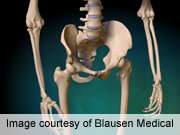Patients undergoing total hip arthroplasty who have coexistent lumbar spine disorders do not report as much improvement in pain and function after arthroplasty compared with patients without lumbar disorders, according to a study published in the May issue of The Spine Journal.
(HealthDay) -- Patients undergoing total hip arthroplasty (THA) who have coexistent lumbar spine disorders (LSDs) do not report as much improvement in pain and function after arthroplasty compared with patients without lumbar disorders, according to a study published in the May issue of The Spine Journal.
Heidi Prather, D.O., from the Washington University School of Medicine in St. Louis, and colleagues retrospectively examined 3,206 patients who underwent THA from 1996 to 2008. To identify which patients were also evaluated by a spine specialist, the International Classification of Diseases, Ninth Revision billing codes for LSDs were cross-referenced with patients who had undergone a THA. Functional outcomes were measured using the modified Harris Hip Score (mHHS) and University of California Los Angeles (UCLA) hip questionnaire, and physician medical charges were assessed.
The researchers found that a higher number of LSD patients were significantly older (64.5 years) compared with patients treated with THA alone (58.5 years). Compared with the THA + LSD group, patients in the THA alone group had significantly greater improvement in the mHHS, UCLA score, and pain. On average, patients in the THA + LSD group incurred significantly more in charges per episode of care ($2,668) and significantly more days per episode of care, compared to patients with THA alone.
"Patients undergoing THA alone had greater improvement in function and pain relief with fewer medical charges as compared with patients undergoing a THA and treatment for an LSD," the authors write.
Several authors disclosed financial ties to the pharmaceutical and medical device industries.
More information:
Abstract
Full Text (subscription or payment may be required)
Journal information: Spine Journal
Copyright © 2012 HealthDay. All rights reserved.





















